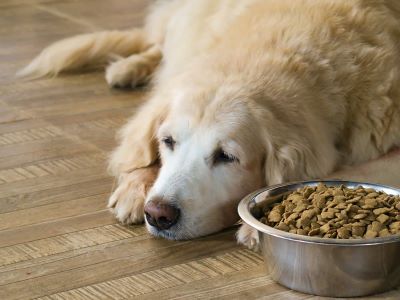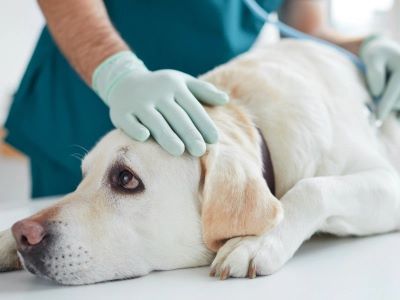Stomach cancer can develop in dogs just like in people. There are many signs of stomach cancer in dogs but mainly it happens when cells in the stomach start to grow out of control.

As more and more cancer cells form, they can form lumps or tumours in the stomach. This is not common in dogs but it does happen, that’s why catching it early is important as this is hard to treat after it spreads.
Treating early gives the dog the best chance to live longer. The vet can check for cancer or other illnesses related to it. Let’s understand this in detail and how can we help out our dogs in this situation!
Signs of Stomach Cancer in Dogs?
Stomach cancer, also called gastric cancer, is when abnormal stomach cells multiply out of control and form tumours in a dog’s stomach. Catching stomach cancer early is critical because it is difficult to treat once it spreads to other parts of the body.
According to the American Animal Hospital Association (AAHA), the most common types of cancer in dogs are Lymphoma, Melanoma, Hemangiosarcoma, Osteosarcoma, and Mast cell tumour.
Understanding the signs of stomach cancer allows owners to get help for their dogs sooner when treatment is most effective. Let’s see the signs of stomach cancer in detail:

1. Weight Loss
“Sudden or unintended weight loss is one of the most common signs of stomach cancer in dogs“, says the experts at Hill’s Pet Nutrition.
Cancer causes the body to burn more calories and can suppress appetite. An otherwise healthy dog that starts losing weight for no reason should be evaluated by a vet.
2. Lack of Appetite
Stomach cancer can also decrease appetite. Dogs may seem less interested in food, only take a few bites, or act like food smells or tastes bad when there is an undiagnosed stomach tumour.
Any major or long-lasting changes in eating should be addressed right away as it may indicate growing cancer.
3. Vomiting
Frequent vomiting or throwing up more than usual is another red flag symptom.

In stomach cancer, persistent vomiting may produce vomit that contains blood and has an unusual colour or texture. Throwing up blood signals bleeding in the stomach and always warrants rapid medical care.
4. Diarrhoea
Cancer growing in the stomach can also lead to diarrhoea, loose stools, or changes in bowel movements like a new, foul odour.
Uncontrolled diarrhoea or bloody diarrhoea is especially worrying and indicates a veterinary exam.
5. Stomach Pain
Dogs with stomach cancer may whimper, grunt, or act restless due to discomfort or pain in the abdominal area.
They may also resent having the abdomen touched or palpated during an exam due to stomach pain.

6. Visible Swelling
In some cases, a tumour growing in the stomach may be large enough to cause visible bloating or distention of the abdomen.
A swollen, bloated belly that comes on suddenly warrants an urgent trip to the vet.
7. Lethargy
Stomach cancer tends to make dogs feel unwell and fatigued. They may seem more tired or sleep more often.
Dogs may also withdraw from normal daily activities or play. Such lethargy and behavioural changes can have many causes but require further diagnostics.
Why Early Detection Matters?
The signs of stomach cancer often overlap with other more benign illnesses, so identifying cancer early is challenging. That is why any lasting appetite, vomiting, or diarrhoea issues should prompt a full veterinary workup.

Stomach cancer is easiest to control and has better outcomes when found early before spreading widely. Early detection and treatment can significantly extend a dog’s lifespan.
So staying alert to subtle changes in a dog’s health and behavior is essential for getting them timely care. Close monitoring paired with regular vet checkups offers dogs their best shot at beating stomach cancer.
Respiratory Symptoms
The respiratory system indicates various health concerns in dogs. Difficulty in breathing, Panting and laboured breathing suggest issues.
Difficulty breathing refers to any noticeable effort or discomfort a dog experiences while inhaling or exhaling. Laboured breathing involves visible and pronounced effort during the breathing process.

While panting is a normal and natural way for dogs to cool down, excessive or unexplained panting can be a sign of an underlying problem. Dogs may pant due to stress, pain, or respiratory difficulties.
Blue or pale gums can signal inadequate oxygenation, indicating a serious problem requiring immediate attention.
Understanding these symptoms is crucial for proactive care. If you notice any of these signs do not hesitate to call in professional help!
Diagnostic Procedures of Stomach Cancer in Dogs
Diagnosing cancers in dogs often takes multiple tests. Let’s see how vets do this[1]:
- At first, the vet does a full physical exam on the dog. The vet will dog’s overall health and feel their abdomen for any sign of illness. Signs like weight loss, vomiting, swelling in the stomach or pain may point to an issue.
- The vet will ask you questions about your dog’s appetite change, energy levels, bathroom habits, and behaviours, to further help them in identifying the problem.
- When your dog is unwell, the vet may suggest blood tests, such as a complete blood count (CBC) and a blood chemistry panel. These tests help the vet examine various aspects of the blood to identify potential health issues.
- If stomach issues are suspected after the exam and blood work, the vet will suggest imaging tests. X-rays provide images of organs and tissues inside the dog’s body and may reveal stomach abnormalities like tumours. Ultrasounds help accurately identify the cause and locations of problems.
- Biopsies are the most accurate way to diagnose stomach cancer, an endoscope through the mouth into the stomach to collect biopsies of the tissue. Now these samples are analyzed on a cellular level.

Treatment Options
Stomach cancer in dogs is a serious condition that requires quick medical attention. Let’s see common treatment options for stomach cancer in dogs:
Surgery involves removing the tumour and the affected part of the stomach[2]. Sometimes part of the small intestine. Surgery is usually the first line of treatment for stomach cancer in dogs.
In chemotherapy the use of drugs to kill cancer cells. Chemotherapy is advised for malignant stomach tumours, especially if there’s a risk of spread, or they have already spread to other body parts.
In radiation therapy, high-energy radiation kills cancer cells. Radiation therapy may be used together with chemotherapy or surgery to shrink tumours or destroy cancer cells.
Palliative care is focused on providing relief from the symptoms of stomach cancer in dogs, rather than curing the disease. This may include pain management, nutritional support, and other therapies to improve the dog’s quality of life.
Prevention and Supportive Care
There are things owners can do to reduce risk and support dogs with disease. However, there are no guaranteed ways to prevent stomach cancer in dogs. Let’s see what are the preventive steps we can take to help our canine companion:
Regular Vet Check-Ups
Regular vet check-ups every 6 to 12 months allow vets to monitor dogs for early signs of illness and address concerns quickly.
The vet can prescribe Bloodwork and diagnostics during checkups are crucial. Regular vaccinations keep immune systems strong.

Healthy Diets
Ensure your dog is having a balanced and appropriate diet to support their body health. Make sure your diet is reliable by vets to prevent deficiencies or excess that could impair immunity.
Avoid giving them table scraps, toxic foods, and unnecessary treats to reduce the risk of obesity and other health issues.
Monitoring Changes
Notice early subtle shifts like low energy or vomiting and then reporting to the vet ASAP makes a difference in detecting cancer before it’s too late and it spreads. Feed them the right balanced diet. Look after your senior dogs.
The partnership between informed pet parents and vets reduces the signs of stomach cancer in dogs. Working as a team is key to dogs living their best lives.
FAQs
1. How Can You Tell if a Dog Has Stomach Cancer?
The signs of stomach tumours develop gradually over weeks to months. They include chronic intermittent vomiting, lack of appetite, lethargy, and weight loss. The vomit may be blood-tinged or have a “coffee grounds” appearance. This is related to tumour ulceration (opening) causing bleeding.
2. At What Age Do Dogs Usually Get Cancer?
In our study, the median age at diagnosis was ~9 years (8.8 years), supporting a recommended screening age of 7 for all dogs. For dogs belonging to breeds with an earlier median age at cancer diagnosis (6–7 years), screening should begin as early as age 4.
3. Does a Blood Test Detect Cancer in Dogs?
Blood work generally does not diagnose cancer, but it may give us a clue if something’s abnormal. If the white blood cell count is very high or the red blood cell count is very low, these can be signs that we want to look into, and then we may find cancer.
4. Do Most Dogs Survive Cancer?
One in four dogs will be diagnosed with cancer in their lifetimes, and it’s the leading cause of death in pets beyond middle age. As with people, some canine cancers are more common than others. Fortunately, with treatment, many dogs can continue to live quality lives after a cancer diagnosis.
Conclusion
This whole process and seeing signs of stomach cancer in dogs can be frightening but do not lose hope.
This disease poses many challenges but the outcome can be improved significantly if you provide good care and attention to your dog. Your vet will be your most trusted guide in handling this journey.
Be patient, each dog is different. Staying actively engaged with your dog’s health through routine checks, diet and your love will heal your dog in no time!
Reference:
- Cancer in dogs – 6 types You need to know about | Purina.
- Stomach Tumors | VCA Animal Hospital | VCA Animal Hospitals.



